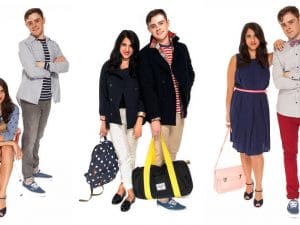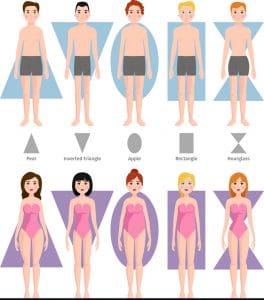- The selection of clothing should be done on the basis of age, season, income, occasion and fashion.
- Age: While selecting fabric one has to think of the age group of the child. For small children, dainty prints in soft colors can be chosen. Nursery prints are not suitable for elementary school children. When the children enter late childhood stage, the boys like masculine colors, for examples blue, grayish blue, and brown and girls like to wear feminine colors like pink, green and red. Some fabrics, which are delicate, are chosen for girls clothing whereas, rough textured fabrics are suitable for adolescent boys.The style of the dress also changes according to the age group of the child. The A-line dresses are suitable for toddlers and infants. Later on, dresses with lots of gathers are suitable for girls’ frocks. In the same way type of collars are suitable for younger age group, for example baby collar is not suitable for adolescent
- Season: Some fabrics and colors are suitable for winter while others are not, for example synthetics; silk and wool are suitable for winter as they are bad conductor of heat. Cotton and blends of cotton with synthetics are good for summer as they are good conductor of heat and absorptive. There are cool and warm colors. The cool colors are associated with coolness, for example, blue, green, white etc. Warm colors are bad conductors of heat and associated with warmth for example, red, golden yellow and orange. So warm colors are suitable for winter, whereas cool colors are chosen for summer.
- Income: Amount of money affects the selection of clothing. Children belonging to high-income group can spend more percentage of money on clothing as compared to low income. They can spend more money on fashionable garments rather than on durable clothes. Parents belonging to low-income group prefer durable clothes rather than delicate ones. So the preference of the clothing changes according to the income of the family. Low socio economic growth gives more importance to durability, comfort and price as compared to becomingness and beauty.
- Occasion: Selection of clothes also changes according to occasion. For daily wear or informal wear, durable dresses with simple designs can be chosen but for occasional or formal wear novel fabrics with new styles are chosen.
- Fashion: Fashionable clothes look beautiful. One looks odd when one go out of fashion. Few fabrics and colors are in fashion while others are not. Some clothes should be brought according to fashion and others should be simple. Children belonging to high-income group can wear fashionable clothes to great extent as compared to low-income group. Too much of fashion should be avoided.
Selection of clothes should be very judicious so that we can buy best clothes by spending minimum amount of money.
The clothes should be compatible to age, personality, and climate and should not be a hindrance in normal working. Some factors affect the selection of clothes, which may vary from person to person as they are influenced by the requirement of the person. These factors are as follows:
Personality
The personality, value and culture of a person can be judged easily from his dress. There are different types of personalities.
Highlighting salient features of the personality and camouflaging the figure flaws to some extent is possible through dress. Improper dressing makes person a laughing stock and causes inferiority complex.
On the other hand, proper dresses help in building self-confidence which is essential for the proper development of personality. This affects our behavior and mannerism and develops harmony and personality.
Clothes are an indication of caste, place, state, and occupation of the person. Clothes affect the personality of the wearer. People who are introverts prefer light and sober colors whereas extroverts like bright and gaudy clothes.
Dresses with delicate patterns and sober colors help in enhancing the natural characteristics of tenderness and feminine. On the other hand, big patterns and straight lines go well with regular, dominating and grand personalities. Some uniforms are reserved for certain professions, which help in enhancing their personality, e.g., wearing white coat by doctors and black by lawyers. Clothes indicate your social status and interest. Simple and elegant clothes are hallmark of a serious personality.
Age
Different clothes are required for different age groups. Therefore, care should be taken in selecting clothes for a particular age group.
(i) Selection of clothes for infants
- An infant sleeps for most of the time, so it is important that his clothes are loose and comfortable.
- These should be made of soft and absorbable cloth (preferably cotton) as they do not irritate the tender and soft skin of the child. Silken and synthetic clothes should not be used for infants in any case.
Infant’s clothes are to be washed quite often, hence, the clothes should be of such material which can be washed and dried easily. The clothes should be unsearched. The seams should be flat; fasteners should not be at the back.
Tight elastic should be avoided. Infant’s clothes should have openings on the front, back or on upper side and it should be head long and closed neck. Instead of buttons, there should be ties and fasteners at the back of the dress as these may hurt the infant clothes because inconvenience in and may get torn by sticking someway
- Very tight clothes are not conducive normal growth.
- If the clothes are shabby, unshaped, not to the liking of their peer group, they may suffer from inferiority complex. They are reluctant to play and with their peers.
- Hazy and dull colors should not | selected for children. Rather bright gaudy colors are good for them.
(iii) Selection of clothes for adolescents

- Adolescents like distinctive and unit colors. Clothes with bright color reflecting enthusiasm, cheerfulness liveliness should be used for them.
- They like clothes that are in fashion their clothes should be creative, stylish and according to the latest fashion.
- Generally adolescents do not like influences of their parents and regarding their clothes.
(iv)Selection of clothes for adults.

- In adulthood, the clothes undergo change. Simple and elegant clothes desirable for mature and elderly
- Clothes with design and flowering print look childish.
- Clothes should be chosen after analysis of the color of the skin, a| and body figure.
- In this age, more emphasis should be the profession, occasion, and price than on the prevalent fashion. In absence of any of this consideration the dress would look awkward.
(v) Selection of clothes for old. Some problems are come regarding the clothes of the people.

- In this period, there is loss of flexibility in the body which causes inconvenience in movements, hence, clothes should be| loose and comfortable.
- Eyesight also gets weak and hence big buttons with button holes should be used in place of hooks. Use of zip is also convenient.
- Their dresses should be in consonance with their age.
- Clothes should be light and easy to wear. They should have simple designs and easy to wear from either side with durable stitching.
- Clothes should be stain resistant, easily washable and wrinkle resistance as the elders may not have enough energy to launder their clothes frequently. Thus, we find that age is an important factor in selection of clothes.
Climate
The main purpose of clothes is to cover the body. Clothes protect us from heat and cold and help us in maintaining body temperature in adverse circumstances. Hence, knowledge of selecting the clothes according to the climate is essential.
Warm, thick and bright colored clothes should be used in winter whereas cool, soft and light colored clothes in summer. These should have sweat absorbing quality. In rainy season, we need such clothes as may dry up soon and are wrinkle free e.g., nylon.
Clothes compatible to a person should be soothed both to the user and onlooker, e.g., a person wearing silken clothes in sultry summer is irritable to the wearer as well as the onlooker.
Occupation

Clothing is associated with profession also. Working people should wear formal clothes. They should be simple, neat and clean. Vulgar and improper clothes should be avoided. Clothes should give a feeling of being smart, active and sober. We all would like to wear such clothes that may wearer not cause any hindrance in our working.
If you are a physical instructor, your clothes should be loose and comfortable so that you may give a good demonstration. Farmers need strong and durable clothes and should also protect them from sunshine.
Businessmen should wear sober and modest clothes. Persons who are going to travelling should wear such clothes which are easy to wash and do not require frequent ironing, e.g., terry cot, decagon etc.
Industrial workers wear special type of uniform. People serving in army, police and railways have their own distinctive uniform. Simple and sober clothes are required in classrooms. Sportsmen need durable and porous clothes for sweat absorption. Doctors and nurses wear white clothes. All these variations are on account of different professions.
Figure

Every person has unique figure. Some are tall or short, fat or lean and thin. Some are of normal height and width. A man should wear clothes in accordance to his figure irrespective of latest trends in fashion and design.
Whatever is the body shape, clothes can make it look different. By judicious use of colors and clothes the figure flaws can be camouflaged or salient features highlighted. For example, persons who intend to look taller and thinner should wear clothes that are plain and of single color and with vertical lines and designs. Similarly, those who wish to look shorter and fatter should wear horizontal designs and with two or more colors in their dress, e.g., if the salwar is of light color, the shirt should be of dark color with horizontal lines.
They may also use frills, piping in their dress to look fat. For a tall and fat lady, clothes with diagonal lines are more suitable. They should also not wear very light or loose clothes. Short coat and jacket too, give a feeling of shortness. All types of clothes do not suit to all body figures. For a fat person light and soft clothes, and heavy and fluffy clothes-like organdy and taffeta, should be used for a lean and thin person.

